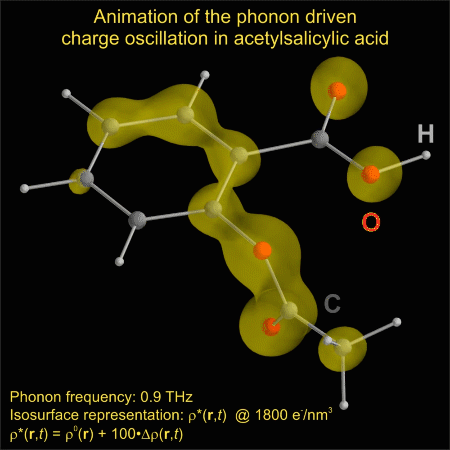
Thousands of x-ray snapshots each lasting just a quadrillionth of a second have revealed how tiny rotations of a methyl group in aspirin drive electron relocation across the entire molecule – huge distances in molecular terms. The resulting molecular movie might help explain why aspirin’s elusive second crystal type – discovered only a decade ago – is unstable above –173°C.
Acetylsalicylic acid, or aspirin, has been made on an industrial scale since the end of the 19th century. In the 1960s, scientists tried to find out if other forms of aspirin crystal exist since polymorphs often have different biological properties. However, experiments were inconclusive. Half a century later, a second polymorph was finally made at very low temperatures.
‘The two aspirin forms differ in part with respect to the local environments around the methyl groups,’ says Gautam Desiraju from the Indian Institute of Science in Bangalore who, in 2007, was part of the team that established aspirin II’s structural details. Theoretical calculations suggested that hybrid modes – molecular vibrations within the crystal coupled to movements of the electron cloud – could reveal why aspirin I is more stable.
A team around Christoph Hauf and Michael Wörner from the Max Born Institute for Nonlinear Optics and Short Pulse Spectroscopy in Berlin, Germany, has now done the first x-ray experiments that show aspirin’s hybrid modes in action. Although on their own they don’t explain why aspirin I is the stable polymorph, the insights could inform further theoretical investigations.
Using a laser, the researchers triggered rotation of aspirin’s methyl group. Ultrashort x-ray pulses, each only a few femtoseconds long, were then diffracted off the crystal to take snapshots of each of the molecule’s electronic states.
Although aspirin’s methyl sits at the edge of the molecule, its rotation kicks off an electron redistribution all over the molecule. The rotation displaces the methyl by less than a picometre, yet the electron movement propagates over distances on the order of 100 picometres. ‘It’s a hallmark of hybrid modes: tiny nuclear motions that induce electron relocation over huge distances,’ explains Hauf.
‘The fact that the methyl rotation initiates an electron redistribution isn’t necessarily an intuitive result,’ says Desiraju. ‘Or at least you might not have expected that you can measure it.’
The electrons shift is most pronounced around the benzene ring. ‘But it’s not just [the electrons] sloshing from one side to the other, back and forth like a bathtub being tipped to one side,’ Hauf says. ‘[The electron density] is moving in a much more complex fashion: from the middle of the π-system to the outside and back again.’
Hauf hopes that their work will help access other unexplored aspirin polymorphs. ‘Nobody has definitely predicted that aspirin I is the most stable of all,’ he says. Desiraju adds: ‘I’d like to see a similar study on form II – I’d bet that the methyl rotation is different in that form.’
References
C Hauf et al, Struct. Dyn., 2019, 6, 014503 (DOI: 10.1063/1.5079229)















No comments yet